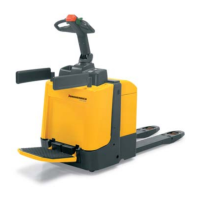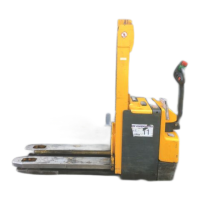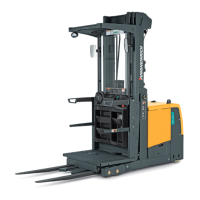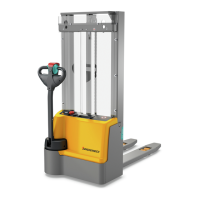E 11
0602.GB
Driving up an incline
m
The load must be transported facing the incline!
Safety measures against “rolling down” of the truck:
With the controller (8) set to neutral, the service brake is automatically applied after a
brief jolt (the controller detects the truck’s rolling down on an incline). The controller
(8) is used to release the service brake; the speed and driving direction are set as
desired.
m
When the service personnel has switched off the coast-down brake, only the service
and/or the counter-current brake can be used.
Steering
f
In narrow bends, the driver will be positioned at the outer contours of the truck.
– Swivel the control shaft (4) to left or right.
The position of the control shaft corresponds to the position of the steered driven
wheel.
Electrical steering
The electric steering system is self-monitoring.
The steering control systems monitors the fault frequency over a certain period. If the
same fault is detected several times during this period, the steering control reduces
the driving speed of the truck to low speed. If such a fault occurs, the driving speed
is not reset to normal speed by switching the truck off and on again. This method pre-
vents the cancellation of a fault without eliminating the fault.
Braking
f
The braking behaviour of the truck strongly depends on the state of the floor. This
must be taken into account by the driver for his driving behaviour.
The truck may be braked in three ways:
– either by counter-current braking (controller (8))
– or by means of the service brake (control shaft (4))
– or by using the generator brake (coasting)
f
In case of emergencies, the truck must only be braked using the service brake
(control shaft (4)).
m
During normal operation, the generator brake and counter-current braking should be
applied. These methods of braking reduce wear and require less energy (energy
recovery).
E 11
0602.GB
Driving up an incline
m
The load must be transported facing the incline!
Safety measures against “rolling down” of the truck:
With the controller (8) set to neutral, the service brake is automatically applied after a
brief jolt (the controller detects the truck’s rolling down on an incline). The controller
(8) is used to release the service brake; the speed and driving direction are set as
desired.
m
When the service personnel has switched off the coast-down brake, only the service
and/or the counter-current brake can be used.
Steering
f
In narrow bends, the driver will be positioned at the outer contours of the truck.
– Swivel the control shaft (4) to left or right.
The position of the control shaft corresponds to the position of the steered driven
wheel.
Electrical steering
The electric steering system is self-monitoring.
The steering control systems monitors the fault frequency over a certain period. If the
same fault is detected several times during this period, the steering control reduces
the driving speed of the truck to low speed. If such a fault occurs, the driving speed
is not reset to normal speed by switching the truck off and on again. This method pre-
vents the cancellation of a fault without eliminating the fault.
Braking
f
The braking behaviour of the truck strongly depends on the state of the floor. This
must be taken into account by the driver for his driving behaviour.
The truck may be braked in three ways:
– either by counter-current braking (controller (8))
– or by means of the service brake (control shaft (4))
– or by using the generator brake (coasting)
f
In case of emergencies, the truck must only be braked using the service brake
(control shaft (4)).
m
During normal operation, the generator brake and counter-current braking should be
applied. These methods of braking reduce wear and require less energy (energy
recovery).
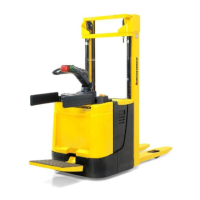
